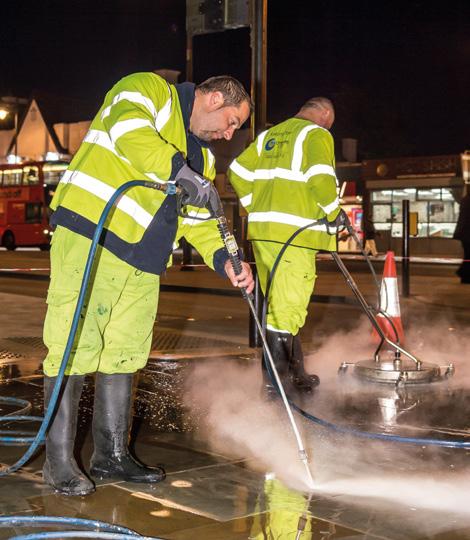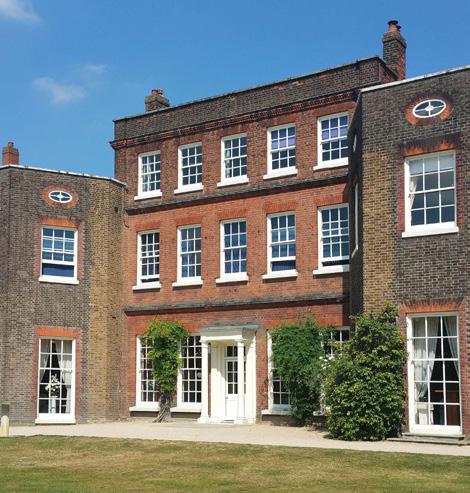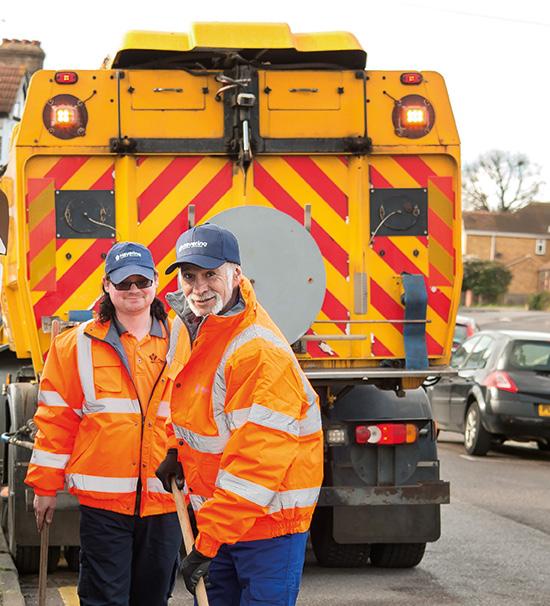
12 minute read
Gross Expenditure and the Council Tax
Levying bodies
The Council Tax you pay includes money that the Council has to collect for other organisations that provide services Londonwide. The organisations that make a levy on the Council are shown in this section.
East London Waste Authority (ELWA)
ELWA has the statutory responsibility for the disposal of household and commercial waste collected by the London Boroughs of Barking & Dagenham, Havering, Newham and Redbridge, and for the provision of Reuse and Recycling Centres in its area. Waste disposal is carried out under a 25year Integrated Waste
Management Services
Contract by Renewi plc. ELWA receives funding support via the government’s Private Finance Initiative.
Budget 2023/2024
ELWA’s total levy requirement is £72,846,000 (2022/23: £72,350,000). The 2023/24 budget includes a signifcant infationary increase in contract costs. This is offset by a decrease in the total waste tonnage and a reduction in capital fnancing costs (both relative to the 2022/23 budget) and the forecast 2022/23 budget surplus. Further information can be found at http:// eastlondonwaste.gov.uk/. The increase for the London
Borough of Havering is 0.23%.
The major part of the ELWA Levy is apportioned on the basis of relative amounts of household waste delivered to ELWA by each of the four constituent London Boroughs, with the remainder appointed according to their Council Tax Bases.
The levy on the London Borough of Havering for 2023/24 £18,056,000 (2022/23: £18,015,000).
Waste disposal is carried out under a 25year Integrated Waste Management Services Contract by Renewi plc. ELWA receives funding support via the government’s Private
Lee Valley Regional Park Authority Budget Levy Changes 2022/2023 to 2023/2024
Lee Valley Regional Park is a unique leisure, sports and environmental destination for all residents of London, Essex and Hertfordshire.
The 26 mile long, 10,000 acre Park, much of it formerly derelict land, is partly funded by a levy on the council tax. This year there has been a 9 percent increase in this levy. Find out more about hundreds of great days out, world class sports venues and award winning parklands at www.visitleevalley.org.uk
Havering’s share of the levy is calculated in proportion to the Council Tax Base and is £228,973 for 2023/24 (2022/23: £211,482).
Further details on how this budget is spent and the amount each council contributes can be found at www.leevalleypark.org.uk
The Environment Agency
The Environment Agency is a levying body for its Flood and Coastal Erosion Risk Management Functions under the Flood and Water Management Act 2010 and the Environment Agency (Levies) (England and Wales) Regulations 2011.
The
The Anglian Eastern Region Committee. Money is spent of the Environment Agency on the construction of new has powers in respect of food defence schemes, the food and coastal erosion maintenance of the river risk management for 2,993 system and existing food kilometres of main river and defences together with the along tidal and sea defences operation of a food warning in the area of Anglian Eastern system and management of Regional Flood and Coastal the risk of coastal erosion.
The fnancial details are:
The total Local Levy raised has increased from £3,518,313 in 2022/2023 to £3,553,496 for 2023/2024.
The Thames Region of the Environment Agency has powers in respect of food and coastal erosion risk management for 5,200 kilometres of main river and along tidal and sea defences in the area of Thames Regional Flood and Coastal Committee.
The fnancial details are:
Money is spent on the construction of new food defence schemes, the maintenance of the river system and existing food defences together with the operation of a food warning system and management of the risk of coastal erosion.
The total Local Levy raised has increased from £12,281,930 in 2022/2023 to £12,526,341 for 2023/2024.
The majority of funding for food defence comes directly from the Department for Environment, Food and Rural Affairs (Defra). However, under the new Partnership Funding rule not all schemes will attract full central funding. To provide local funding for local priorities and contributions for partnership funding the Regional Flood and Coastal Committee recommend through the Environmental Agency a local levy. A change in the gross budgeted expenditure between years refects the programme of works for both capital and revenue needed by the Regional Flood and Coastal
Committee to which you contribute. The total Local Levy raised by this committee has increased by 1.99 percent for the Thames Region and 1.0 per cent for the Anglian Eastern Region.
The London Pensions Fund Authority (LPFA)
The London Pensions Fund former employees of the London levy is payable in Authority (LPFA) raises a Greater London Council all boroughs, the Inner levy each year to meet (GLC), the Inner London London levy only in Inner expenditure on premature Education Authority (ILEA) London Boroughs (including retirement compensation and the London Residuary the City of London). The and outstanding personnel Body (LRB). fgures show the total to be matters for which LPFA is responsible and cannot For 2023/24, the income raised and, in brackets, the charge to the pension fund. to be raised by levies is percentage change on the These payments relate to set out below. The Greater previous year.
Greater London Authority Introduction
The Mayor of London’s budget for the 2023-24 fnancial year sets out his priorities to support London’s recovery from the COVID-19 pandemic and to tackle the huge social, health and economic inequalities which it has exposed and exacerbated - inequalities which have become even more apparent as a result of the current cost of living crisis. It supports job creation and London’s business community, our city’s future growth and economic success and the Mayor’s vision to rebuild London as a greener, cleaner and safer city with stronger and more cohesive communities.
This year’s budget will provide resources to improve the key public services Londoners need and help address the cost of living crisis. This includes delivering more genuinely affordable homes, funding to maintain the capital’s transport services and programmes to tackle toxic air pollution and the climate emergency. The budget also provides resources to support jobs and growth, fund skills and retraining programmes, help rough sleepers, invest in services for children and young people and make London a fairer and cleaner place to live. Moreover, it prioritises resources for the Metropolitan Police and London
Fire Brigade to keep Londoners safe, including violence reduction initiatives, support for victims of crime, recruitment drives for additional frontline offcers and projects to divert vulnerable young people away from the criminal justice system.
In light of the signifcant reductions in fares revenue since the pandemic, it has been necessary to provide additional resources through local taxation income to maintain London’s transport system including investing in preserving the bus network. However, this budget remains focused on delivering a swift and sustainable economic recovery across the capital as well as building the better, brighter, fairer future all Londoners want and deserve.

Council tax for GLA Services
The GLA’s share of the council tax for a typical Band D property has been increased by £38.55 (or 74p per week) to £434.14. The additional income from this increase in council tax will fund the Metropolitan Police and the London Fire Brigade, and will also go towards ensuring existing public transport services in Council taxpayers in the City London can be maintained, of London, which has its own meeting requirements police force, will pay £142.01. set by the government in funding agreements.
Controlling costs at City Hall and delivering the Mayor’s key priorities
The Mayor’s budget includes signifcant savings across the GLA Group in 2023-24, including tens of millions of pounds over the frst fve years following moving City Hall from Tower Bridge to the Royal Docks. These savings have allowed him to release resources to help meet his key priorities. His budget includes plans to invest £6.9 billion to allow 116,000 affordable homes starts within London by the end of this year and an additional 165,000 affordable homes starts by 2026, as well as allocating resources to tackle homelessness and reduce rough sleeping.
The Mayor has already taken steps to improve air quality in London by introducing the Ultra Low Emission Zone (ULEZ) in central London in April 2019, which was expanded to the North and South Circular roads in Autumn 2021. The Mayor has also created a £110m scrappage scheme providing fnancial assistance to help eligible Londoners scrap or retroft their highest polluting vehicles to prepare for the planned expansion of the ULEZ London-wide from 29 August 2023. He has continued to roll out his Green New Deal for London to address the climate emergency, with the objective of helping to create jobs and to double the size of the capital’s green economy by 2030. This work is being supported in 202324 by the allocation of an additional £134 million to be used towards environmental improvement projects in order to help deliver the Mayor’s target to ensure London achieves carbon net zero by 2030.
The Mayor will continue to ask the government to provide the maximum possible ongoing fnancial support to London businesses and Londoners to assist them through the current challenging economic situation including the impact of rising food and fuel infation, rents and interest rates. He will also maintain investment in skills and retraining to help tackle unemployment and support Londoners to secure better paid jobs, as well as supporting the advice sector to help Londoners impacted by the cost of living crisis. The Mayor is also responding to the cost of living crisis by providing £130 million of new funding to ensure all primary school pupils can receive free school meals in the 2023-24 school year.
The Mayor will also work with London’s business community, key investors and other stakeholders to support the economic recovery and ensure that London and Londoners’ interests are protected following the UK’s departure from the European Union. He will provide funding for new projects to bring communities together, tackle social inequality and boost London’s economy, including supporting projects to help small and medium sized businesses.
The Mayor’s Offce for Policing and Crime (MOPAC)
The Mayor published his Police and Crime Plan for 2022-25 in March 2022. This sets out the Mayor’s vision for a city in which Londoners are safer – and feel safer. His key priorities include providing a better criminal justice service in London to ensure victims of crime are better supported, keeping children and young people safe, tackling the harm caused by drugs, reducing reoffending by the most violent and high-risk groups and preventing hate crime. He has taken steps to ensure London’s police service has the resources it needs to put more offcers on the streets to suppress violence, including dealing with violence against women and girls, and responding to the demands and pressures of policing a capital city. He has also provided resources to tackle domestic violence and is increasing investment in violence reduction initiatives.
The Plan also outlines the action the Mayor is taking to continue to hold the Metropolitan Police Service (MPS) to account, ensuring all Londoners have trust and confdence in their police force and standards within the wider force are improved. The budget supports the new Metropolitan Police Commissioner in delivering this vital work.
The Mayor published his Action Plan in November 2020 to improve trust and confdence in the MPS and to address community concerns about disproportionality in the use of certain police powers affecting Black Londoners. The Mayor has committed, as part of the action plan, to invest £1.7 million per annum, for a three year period from 2021-22 to 2023-24, to develop greater community involvement in police offcer training and in the recruitment and progression of Black offcers in the MPS.
The MPS must rise to meet these challenges at a time of acute fnancial pressure. As a result of the net reduction in resources from the Home Offce for policing between 2010 and 2019, the MPS had to close more than 100 police stations and remove over 3,300 Police Community Support Offcers and 4,500 police staff in order to minimise reductions to front line offcer numbers.
The Mayor is raising the police element of his council tax precept paid in the 32 London boroughs (but not the City of London which has its own police force) by £15 for a typical Band D property, as assumed in government calculations of police spending power. The additional revenues will help raise £22 million to fund the recruitment of 500 additional Police Community Support Offcers (PCSOs). In all, through his decisions in this and previous budgets, the Mayor has funded an additional 1,300 police offcer posts from locally raised revenues.

Transport for London (TfL)
TfL has faced signifcant fnancial challenges as a result of the reduced levels of ridership due to the pandemic since March 2020, which has led to a reduction in fare revenues. The Mayor continues to work with the government to secure a sustainable long-term funding settlement for TfL to allow him to continue to invest in the transport network while making it more reliable and accessible. The Mayor’s priorities for TfL, subject to funding constraints where applicable, and key achievements include:
• Working with London boroughs to maintain existing concessionary travel and assisted door to door transport schemes. This includes, for example, maintaining free bus and tram travel for under 18s as well as free off-peak travel across the network for older Londoners, the disabled, armed forces personnel in uniform and eligible armed services veterans and protecting the Taxicard and Dial a Ride schemes.
• Completing the fnal stages to deliver the full operation of and timetable for the Elizabeth line by no later than May 2023. The line has increased central London’s rail capacity by ten per cent and saw over 100 million passenger journeys during its frst eight months. This follows on from the opening of Northern line extension to Nine Elms and Battersea Power Station in September 2021.
• Rolling out new trains on the Piccadilly line, with the frst new trains serving customers from 2025.
• Enhancing capacity on the London Underground and rail services, and upgrading key stations such as Bank/ Monument station, Old Street and Elephant and Castle as well as securing government funding to make Leyton and Colindale stations step free.
• Making public transport more accessible for everyone. All Elizabeth line stations will be step free.
• Delivering the local regeneration and housing benefts arising from completing the extension of London Overground on the Gospel Oak to Barking Line to serve Barking Riverside in July 2022.
• Expanding capacity and commencing rolling out new trains on the DLR network in 2024.
• Maintaining the Bus and Tram one-hour Hopper fare and investing to sustain existing journey times and reliability on the bus network.
• Continuing the electrifcation of London Buses so that all are emission free by 2037 at the latest.
• Tackling London’s toxic air quality including extending the ULEZ London-wide. The Mayor has introduced a £110 million vehicle scrappage scheme for small businesses and Londoners in receipt of low income and disability benefts.
• Investing in schemes designed to make walking, cycling and public transport safer, cleaner and more appealing in partnership with London boroughs
Fire Commissioner (LFC)
The Mayor’s funding ensures that the London Fire Brigade’s (LFB) frst and second fre engines attending an incident arrive within 10 minutes on at least 90 per cent of occasions and 12 minutes on at least 95 per cent of occasions respectively, after being dispatched. A new Community Risk Management Plan came into effect in January 2023 covering the period to 2029 replacing the previous London Safety Plan.

The Mayor is providing resources to roll out a transformation programme so that the LFB can implement the recommendations of the Grenfell fre inquiry, including investing in the new vehicles and equipment required. The London Fire Commissioner, with the full support of the Mayor, is also committed to implementing the deep-rooted reform needed to the culture and systems within the LFB.
London Legacy Development Corporation (LLDC)
The LLDC was set up to ensure that the city benefts from a long-term legacy from the London 2012 Olympic and Paralympic Games. The Mayor’s 2023-24 budget provides funding to complete the construction of East Bank, one of the world’s largest and most ambitious cultural and education districts, in Queen Elizabeth Olympic Park. It will bring an additional 1.5 million visitors to the Park and surrounding area each year, and more than 2,500 jobs will be created generating an estimated £1.5 billion for the local economy.
Old Oak and Park Royal Development Corporation (OPDC)
The OPDC has been build on the regeneration
The Mayor’s 2023-24 budget established to support the benefts which High Speed 2 provides additional resources creation of 65,000 new jobs (HS2), the Elizabeth line and to enable the Corporation and at least 24,000 new the Great Western Mainline to start early delivery of its homes in west London over stations at Old Oak Common programme. the next 20 years. It will are expected to bring locally.
Summary of GLA budget
The tables below show where the GLA’s funding comes from and the reasons for the year on year change in the budget. It also explains how the GLA has calculated the sum to be collected from council tax (the council tax requirement). Overall the council tax requirement has increased because of the extra resources for the Metropolitan Police and the London Fire Brigade and to secure funding to maintain existing transport services including buses and the tube network.
There has been a 1.6 per cent increase in London’s residential property taxbase. Find out more about our budget at: www.london.gov.uk/budget



